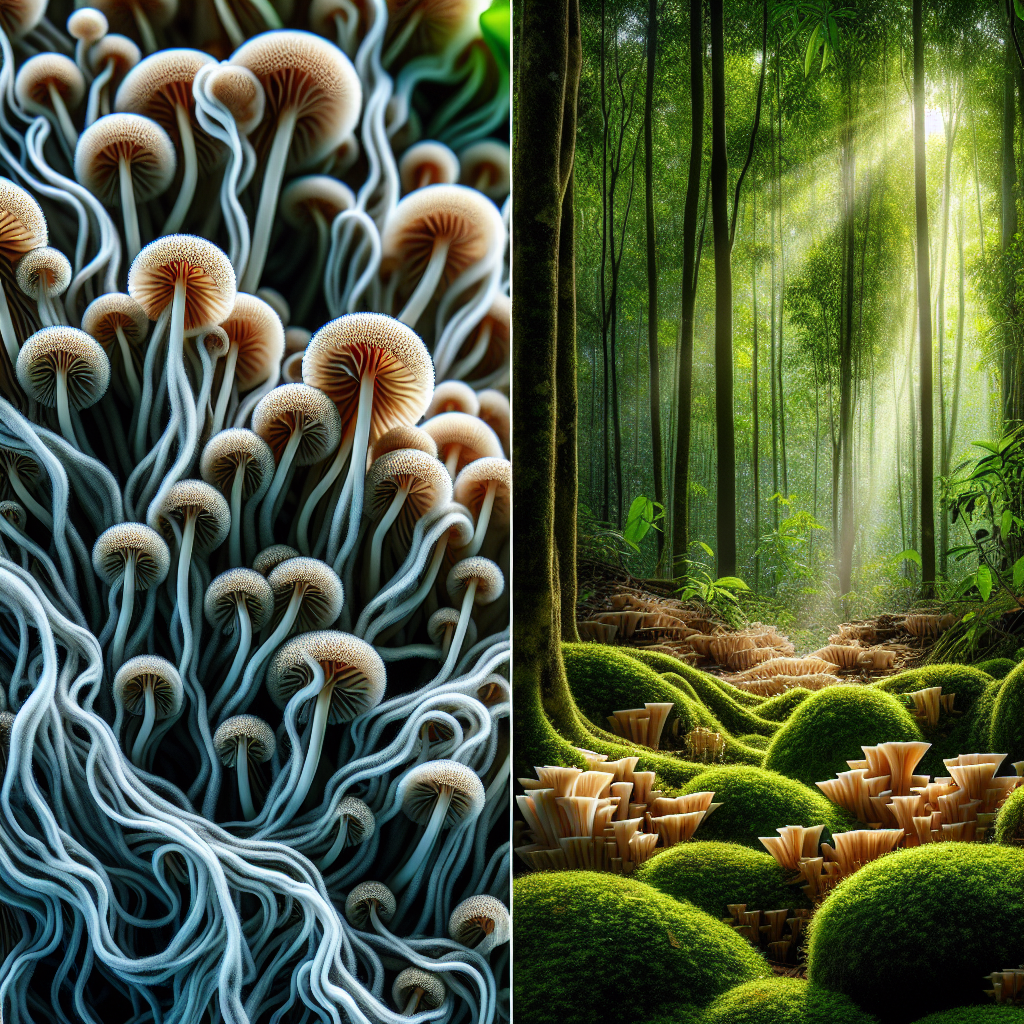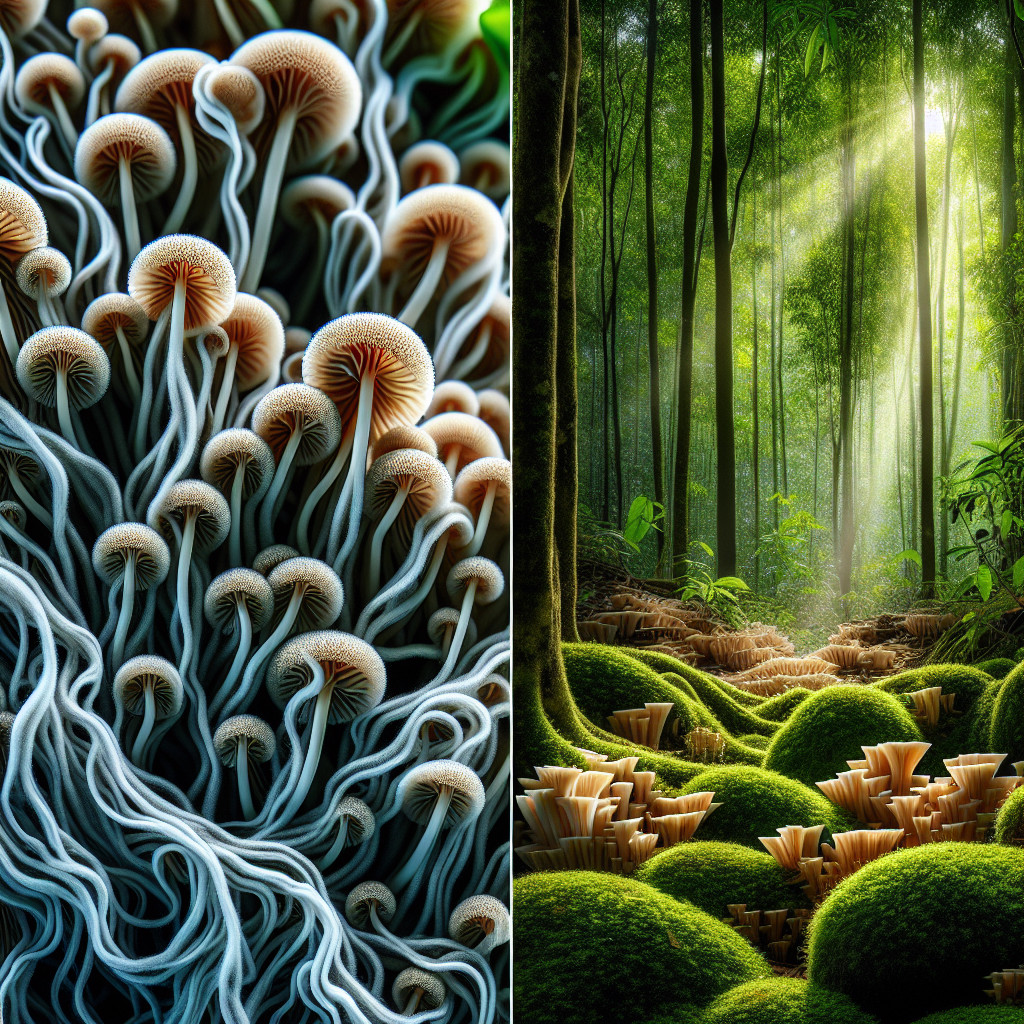In “The Wonderful World of Mycelium Shrooms”, your journey begins into the fascinating domain of fungal networks, a realm often concealed beneath our feet. This fascinating article uncovers the intricacies of these intricate fungal networks, known as mycelium, which serve as the backbone to many shroom varieties. The article will immerse you in the often-overlooked significance of these fungal structures and their contribution to our ecosystem. Discover the biological marvels that lie within the world of mycelium shrooms.

Understanding Mycelium and Shrooms
The field of mycology, the study of fungi, has explored fascinating organisms, among which mycelium and shrooms are particularly intriguing. These two entities play a crucial role in ecosystems, displaying unique attributes that lend them exciting potential in various fields.
What is Mycelium?
Mycelium is the vegetative part of a fungus. It consists of a complex network of thread-like structures known as hyphae, which collectively form a web-like structure beneath the soil. This efficient network system plays a key role in nutrient absorption from the soil, ultimately supporting the growth of mushrooms.
What are Shrooms?
‘Shrooms’ is a common term referring to mushrooms, specifically those that belong to the Psilocybe genus. They are the fruiting body of the fungi, forming when conditions are right to reproduce. These structures hold the spores that, once released, lead to the formation of new fungi elsewhere.
Relationship Between Mycelium and Shrooms
The relationship between mycelium and mushrooms is a fundamental one. The mycelium’s thread-like network serves as a support system for mushroom development, effectively transferring nutrients to these structures as they form and grow. This interconnection illustrates the critical role mycelium plays in the lifecycle of mushrooms.
Life Cycle of a Mushroom Fungus
To understand mushrooms, it’s essential to delve into their lifecycle, which involves a close interaction with mycelium.
Formation of Mycelium
The formation of mycelium starts with the germination of spores, tiny reproductive cells released by mushrooms. These spores grow into individual hyphae, which then interconnect to create the mycelial network beneath the soil.
Development of Mushrooms
Mushroom development commences when environmental conditions become optimal, with factors such as temperature, moisture, and nutrient availability playing key roles. The mycelium aggregates, forming dense knots that evolve into mushroom pins, which then grow into mature mushrooms.
Role of Mycelium in Mushroom Reproduction
The mycelium plays a pivotal role in mushroom reproduction by nourishing the developing fruiting bodies, ensuring they produce a healthy number of spores. Once mature, these spores are released into the environment, thus completing the lifecycle and perpetuating the next generation of fungi.
Importance of Mycelium in Ecosystems
Mycelium contributes significantly to ecosystems, fulfilling a variety of essential roles.
Mycelium as a Nutrient Recycler
By decomposing organic matter, mycelium helps recycle nutrients in the environment. This process is instrumental in maintaining soil fertility, offering a sustainable solution to nutrient recycling.
Soil Structure Improvement with Mycelium
The extensive mycelial network contributes to soil structure by creating a ‘glue’ that holds soil particles together, thus enhancing its structural integrity and reducing erosion.
Biodiversity Support from Mycelium
By providing a habitat and nutrition source for a host of organisms, mycelium plays a role in supporting biodiversity. This symbiosis strengthens overall ecosystem health.
Commercial Uses of Mycelium Shrooms
The unique properties of mycelium and shrooms open the door to various commercial applications.
Mushroom Production and Farming
Farmers cultivate mycelium for mushroom production, benefiting from the rapid growth and rich nutritional profile of these fungi. Shroom farming has become a profitable enterprise globally.
Mycelium in the Food Industry
Mycelium’s protein-rich composition makes it a beneficial addition to the food industry. It serves as a meat substitute and fortifies foods with added nutritional content.
Biodegradable Packaging and Mycelium
Mycelium’s fibrous and sturdy nature has found applications in biodegradable packaging solutions. It presents an ecologically sound alternative to traditional plastic-based packing materials.
Medicinal Uses of Mycelium Shrooms
Mycelium shrooms carry a wealth of medicinal properties, utilized both traditionally and in contemporary medical research.
Mycelium Shrooms in Traditional Medicine
Various cultures have used shrooms for millennia to treat various ailments, capitalizing on their unique constituents – these include antibacterial, antioxidant, and anti-inflammatory properties.
Research on Therapeutic Properties of Shrooms
Modern medical research has explored mushrooms’ potential in treating various health issues. Studies indicate potential therapeutic benefits in areas including immunity, cardiovascular health, and even mental health.
Potential Health Benefits of Mycelium Shrooms
Potential health benefits of shrooms include increased immune function, reduced inflammation, improved gut health, and aid in managing symptoms of anxiety and depression.
Cultivation of Mycelium Shrooms
With their medicinal and ecological benefits, cultivating mycelium shrooms has gained popularity.
Growing Conditions of Mycelium
The key to growing mycelium lies in simulating its natural conditions. This typically involves a substrate rich in organic matter, optimal temperature, and controlled humidity.
Steps to Cultivate Shrooms at Home
Cultivating shrooms at home involves preparing the substrate, introducing mycelium, maintaining optimal growing conditions, and finally, harvesting the mushrooms themselves.
Troubleshooting Common Cultivation Issues
Common cultivation issues can stem from improper conditions or contamination. These issues can be addressed by ensuring cleanliness during cultivation and closely monitoring temperature and humidity levels.
Different Types of Mycelium Shrooms
There is a wide variety of mycelium shrooms, each with unique characteristics.
Commonly Cultivated Shroom Varieties
Commonly cultivated varieties include Reishi, Shiitake, and Lion’s Mane mushrooms. These species are popular for their distinct flavors and health benefits.
Identifying Wild Shrooms
Identifying wild shrooms requires caution and expertise due to their broad range and potential toxicity. It’s crucial to have a solid understanding of local mushroom species.
Unique Properties of Different Shroom Species
Each shroom species boasts unique properties. For example, some have a higher nutritional value, others carry strong medicinal benefits, and some even possess psychedelic properties.
Psychedelic Shrooms and Mycelium
Certain mushrooms carry psychedelic properties, which have been both used and studied over years.
History of Psychedelic Shroom Use
Historically, cultures worldwide have used psychedelic shrooms for spiritual and religious rituals, owing to their mind-altering effects.
Psychoactive Properties of Certain Shrooms
Certain shrooms contain psilocybin, a psychoactive compound that induces hallucinations and altered states of consciousness when ingested.
Modern Research on Psychedelic Therapy
Modern research investigates the potential use of psychedelic shrooms in treating various mental health disorders, including depression, anxiety, and post-traumatic stress disorder.
Safety and Legality of Mycelium Shrooms
Considerations surrounding the safety and legality of mycelium shrooms are crucial.
Legal Status of Shrooms Worldwide
The legality of shrooms varies worldwide, with certain countries maintaining strict laws against their use, while others allow them for specific purposes, such as medical research.
Potential Health Risks of Shroom Consumption
While shrooms carry health benefits, they also come with potential risks, including adverse physical reactions and psychological distress. It’s vital to consume shrooms responsibly, preferably under professional supervision.
Shroom Identification and Foraging Safety
Effective shroom identification is key to foraging safety. Misidentification can lead to consumption of toxic mushrooms, causing serious health problems.
The Future of Mycelium Shrooms
The future of mycelium shrooms holds exciting prospects, with emerging trends and ongoing research paving the way for new possibilities.
Emerging Trends in Mycelium Use
Emerging trends include the use of mycelium in textiles, building materials, and more. As we embrace more eco-friendly practices, mycelium’s potential applications will likely increase.
Potential Impacts of Climate Change on Shrooms
Climate change has potential impacts on mushrooms, influencing their distribution, production, and quality. Understanding these impacts is crucial for sustainable management practices.
Scientific Frontiers in Mycelium Research
Scientific research is continually exploring new frontiers in mycelium, from their role in carbon sequestration to their potential as a renewable energy source. These prospects underline the significance of mycelium in our world, marking them as tools of the future.
